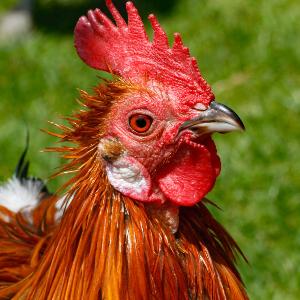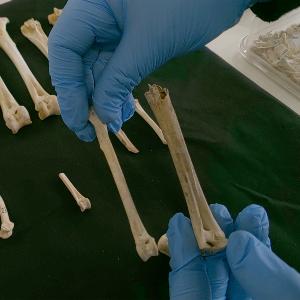Tempting rice
7 Jun 2022
How the chicken came to man and found its way to Europe: Major new international research reveals new evidence about when, where, and how chickens were domesticated
7 Jun 2022
How the chicken came to man and found its way to Europe: Major new international research reveals new evidence about when, where, and how chickens were domesticated

Domestic chicken have only been native to Europe since 800 BC. | © Markus Unsoeld
New research transforms our understanding of the circumstances and timing of the domestication of chickens, their spread across Asia into the west, and reveals the changing way in which they were perceived in societies over the past 3500 years.
An international team of experts with the participation of Joris Peters from LMU Munich and the Bavarian State Collection of Palaeoanatomy has found that an association with rice farming likely started a process that has led to chickens becoming one of the world’s most numerous animals. They have also found evidence that chickens were initially regarded as exotica, and only several centuries later used as a source of ‘food’.
Previous efforts have claimed that chickens were domesticated up to 10,000 years ago in China or Southeast Asia, and that chickens were present in Europe over 7000 years ago.
The new studies show this is wrong, and that the driving force behind chicken domestication was the arrival of dry rice farming into southeast Asia where their wild ancestor, the red jungle fowl, lived. Dry rice farming acted as a magnet drawing wild jungle fowl down from the trees, and kickstarting a closer relationship between people and the jungle fowl that resulted in chickens.

Chickens were not food in Europe for a long time. They were often buried together with people, separated by sex: roosters with men, hens with women. | © Markus Unsoeld
This domestication process was underway by around 1500 BC in the Southeast Asia peninsula. The research suggests that chickens were then transported first across Asia and then throughout the Mediterranean along routes used by early Greek, Etruscan and Phoenician maritime traders. "With their overall highly adaptable but essentially cereal-based diet, sea routes played a particularly important role in the spread of chickens to Asia, Oceania, Africa and Europe", said Joris Peters from the Institute for Paleoanatomy, Domestication Research and History of Veterinary Medicine at LMU.
During the Iron Age in Europe, chickens were venerated and generally not regarded as food. The studies have shown that several of the earliest chickens are buried alone and un-butchered, and many are also found buried with people. Males were often buried with cockerels and females with hens. The Roman Empire then helped to popularise chickens and eggs as food. For example, in Britain, chickens were not regularly consumed until the third century AD, mostly in urban and military sites.
With their overall highly adaptable but essentially cereal-based diet, sea routes played a particularly important role in the spread of chickens to Asia, Oceania, Africa and Europe.Prof. Joris Peters
The international team of experts re-evaluated chicken remains found in more than 600 sites in 89 countries. They examined the skeletons, burial location and historical records regarding the societies and cultures where the bones were found. The oldest bones of a definite domestic chicken were found at Neolithic Ban Non Wat in central Thailand, and date to between 1650 and 1250 BC.

In this photo Julia Best, a researcher from Cardiff, compares a leg bone (the tibiotarsus) from an ancient (right) and a modern chicken. | © Jonathan Rees, Universität Cardiff
The team also used radiocarbon dating to establish the age of 23 of the proposed earliest chickens found in western Eurasia and north-west Africa. “This is the first time that radiocarbon dating has been used on this scale to determine the significance of chickens in early societies”, said Julia Best from Cardiff University. “Our results demonstrate the need to directly date proposed early specimens, as this allows us the clearest picture yet of our early interactions with chickens.”
Most of the bones were far more recent than previously thought. The results dispel claims of chickens in Europe before the first millennium BC and indicate that they did not arrive until around 800 BC. Then, after arriving in the Mediterranean region, it took almost 1,000 years longer for chickens to become established in the colder climates of Scotland, Ireland, Scandinavia and Iceland.
Joris Peters, Ophélie Lebrasseur, Irving-Pease E, Paxinos PD, Best J, Smallman R, Callou C, Gardeisen A, Trixl S, Frantz L, Naomi Sykes, Fuller D, Gregor Larson, The biocultural origins and dispersal of domestic chickens. PNAS, 2022.
Best J, Doherty S, Armit I, Boev Z, Büster L, Cunliffe B, Foster A, Frimet B, Hamilton-Dyer S, Higham T, Ophélie Lebrasseur, Miller H, Joris Peters, Seigle M, Skelton C, Symmons R, Thomas R, Trentacoste A, Maltby M, Gregor Larson & Naomi Sykes. Redefining the timing and circumstances of the chicken’s introduction to Europe and north-west Africa. Antiquity, 2022.